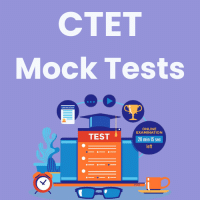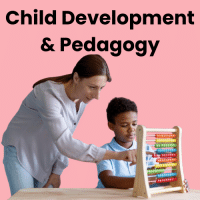CTET & State TET Exam > CTET & State TET Questions > Teachers help learners ‘construct’ their know...
Start Learning for Free
Teachers help learners ‘construct’ their knowledge in English by
- a)giving the learners a lot of assignments and projects that will lead to much practice
- b)correcting every mistake a learner makes and giving the relevant rule of grammar as immediate feedback
- c)giving extensive language drills in which learners practice language items mechanically
- d)enabling them to see the relationship between the prior knowledge and the new knowledge
Correct answer is option 'D'. Can you explain this answer?
Verified Answer
Teachers help learners ‘construct’ their knowledge in English bya)givi...
Teachers help learners construct knowledge by connecting prior knowledge to new concepts.
View all questions of this test
Most Upvoted Answer
Teachers help learners ‘construct’ their knowledge in English bya)givi...
Understanding Knowledge Construction in Learning
In the context of language learning, particularly English, it is essential for teachers to facilitate an environment where learners can actively construct their knowledge. This process is best exemplified by option D: enabling learners to see the relationship between prior knowledge and new knowledge.
Key Reasons for Choosing Option D:
- Building on Existing Knowledge: Learners come to the classroom with their own experiences and understanding. By connecting new concepts to what they already know, teachers help students make meaningful associations, which enhances retention and comprehension.
- Encouraging Critical Thinking: When learners can relate new information to their existing knowledge, they are encouraged to think critically. This process fosters deeper understanding rather than rote memorization.
- Promoting Active Engagement: Linking prior and new knowledge makes learning interactive. Students become active participants in their education, as they are prompted to ask questions and explore connections.
- Facilitating Better Application: By understanding the relationships between different concepts, learners are better equipped to apply their knowledge in various contexts, improving their overall language proficiency.
Limitations of Other Options:
- Option A focuses solely on assignments and projects, which may not address individual learning needs.
- Option B emphasizes correction but may inhibit student confidence and discourage risk-taking in language use.
- Option C involves mechanical drills that can lead to surface-level learning without fostering understanding.
Conclusion:
In conclusion, option D is the most effective approach for helping learners construct their knowledge in English. It emphasizes the significance of connecting new information with what students already know, ultimately leading to a more enriching learning experience.
In the context of language learning, particularly English, it is essential for teachers to facilitate an environment where learners can actively construct their knowledge. This process is best exemplified by option D: enabling learners to see the relationship between prior knowledge and new knowledge.
Key Reasons for Choosing Option D:
- Building on Existing Knowledge: Learners come to the classroom with their own experiences and understanding. By connecting new concepts to what they already know, teachers help students make meaningful associations, which enhances retention and comprehension.
- Encouraging Critical Thinking: When learners can relate new information to their existing knowledge, they are encouraged to think critically. This process fosters deeper understanding rather than rote memorization.
- Promoting Active Engagement: Linking prior and new knowledge makes learning interactive. Students become active participants in their education, as they are prompted to ask questions and explore connections.
- Facilitating Better Application: By understanding the relationships between different concepts, learners are better equipped to apply their knowledge in various contexts, improving their overall language proficiency.
Limitations of Other Options:
- Option A focuses solely on assignments and projects, which may not address individual learning needs.
- Option B emphasizes correction but may inhibit student confidence and discourage risk-taking in language use.
- Option C involves mechanical drills that can lead to surface-level learning without fostering understanding.
Conclusion:
In conclusion, option D is the most effective approach for helping learners construct their knowledge in English. It emphasizes the significance of connecting new information with what students already know, ultimately leading to a more enriching learning experience.

|
Explore Courses for CTET & State TET exam
|

|
Question Description
Teachers help learners ‘construct’ their knowledge in English bya)giving the learners a lot of assignments and projects that will lead to much practiceb)correcting every mistake a learner makes and giving the relevant rule of grammar as immediate feedbackc)giving extensive language drills in which learners practice language items mechanicallyd)enabling them to see the relationship between the prior knowledge and the new knowledgeCorrect answer is option 'D'. Can you explain this answer? for CTET & State TET 2025 is part of CTET & State TET preparation. The Question and answers have been prepared according to the CTET & State TET exam syllabus. Information about Teachers help learners ‘construct’ their knowledge in English bya)giving the learners a lot of assignments and projects that will lead to much practiceb)correcting every mistake a learner makes and giving the relevant rule of grammar as immediate feedbackc)giving extensive language drills in which learners practice language items mechanicallyd)enabling them to see the relationship between the prior knowledge and the new knowledgeCorrect answer is option 'D'. Can you explain this answer? covers all topics & solutions for CTET & State TET 2025 Exam. Find important definitions, questions, meanings, examples, exercises and tests below for Teachers help learners ‘construct’ their knowledge in English bya)giving the learners a lot of assignments and projects that will lead to much practiceb)correcting every mistake a learner makes and giving the relevant rule of grammar as immediate feedbackc)giving extensive language drills in which learners practice language items mechanicallyd)enabling them to see the relationship between the prior knowledge and the new knowledgeCorrect answer is option 'D'. Can you explain this answer?.
Teachers help learners ‘construct’ their knowledge in English bya)giving the learners a lot of assignments and projects that will lead to much practiceb)correcting every mistake a learner makes and giving the relevant rule of grammar as immediate feedbackc)giving extensive language drills in which learners practice language items mechanicallyd)enabling them to see the relationship between the prior knowledge and the new knowledgeCorrect answer is option 'D'. Can you explain this answer? for CTET & State TET 2025 is part of CTET & State TET preparation. The Question and answers have been prepared according to the CTET & State TET exam syllabus. Information about Teachers help learners ‘construct’ their knowledge in English bya)giving the learners a lot of assignments and projects that will lead to much practiceb)correcting every mistake a learner makes and giving the relevant rule of grammar as immediate feedbackc)giving extensive language drills in which learners practice language items mechanicallyd)enabling them to see the relationship between the prior knowledge and the new knowledgeCorrect answer is option 'D'. Can you explain this answer? covers all topics & solutions for CTET & State TET 2025 Exam. Find important definitions, questions, meanings, examples, exercises and tests below for Teachers help learners ‘construct’ their knowledge in English bya)giving the learners a lot of assignments and projects that will lead to much practiceb)correcting every mistake a learner makes and giving the relevant rule of grammar as immediate feedbackc)giving extensive language drills in which learners practice language items mechanicallyd)enabling them to see the relationship between the prior knowledge and the new knowledgeCorrect answer is option 'D'. Can you explain this answer?.
Solutions for Teachers help learners ‘construct’ their knowledge in English bya)giving the learners a lot of assignments and projects that will lead to much practiceb)correcting every mistake a learner makes and giving the relevant rule of grammar as immediate feedbackc)giving extensive language drills in which learners practice language items mechanicallyd)enabling them to see the relationship between the prior knowledge and the new knowledgeCorrect answer is option 'D'. Can you explain this answer? in English & in Hindi are available as part of our courses for CTET & State TET.
Download more important topics, notes, lectures and mock test series for CTET & State TET Exam by signing up for free.
Here you can find the meaning of Teachers help learners ‘construct’ their knowledge in English bya)giving the learners a lot of assignments and projects that will lead to much practiceb)correcting every mistake a learner makes and giving the relevant rule of grammar as immediate feedbackc)giving extensive language drills in which learners practice language items mechanicallyd)enabling them to see the relationship between the prior knowledge and the new knowledgeCorrect answer is option 'D'. Can you explain this answer? defined & explained in the simplest way possible. Besides giving the explanation of
Teachers help learners ‘construct’ their knowledge in English bya)giving the learners a lot of assignments and projects that will lead to much practiceb)correcting every mistake a learner makes and giving the relevant rule of grammar as immediate feedbackc)giving extensive language drills in which learners practice language items mechanicallyd)enabling them to see the relationship between the prior knowledge and the new knowledgeCorrect answer is option 'D'. Can you explain this answer?, a detailed solution for Teachers help learners ‘construct’ their knowledge in English bya)giving the learners a lot of assignments and projects that will lead to much practiceb)correcting every mistake a learner makes and giving the relevant rule of grammar as immediate feedbackc)giving extensive language drills in which learners practice language items mechanicallyd)enabling them to see the relationship between the prior knowledge and the new knowledgeCorrect answer is option 'D'. Can you explain this answer? has been provided alongside types of Teachers help learners ‘construct’ their knowledge in English bya)giving the learners a lot of assignments and projects that will lead to much practiceb)correcting every mistake a learner makes and giving the relevant rule of grammar as immediate feedbackc)giving extensive language drills in which learners practice language items mechanicallyd)enabling them to see the relationship between the prior knowledge and the new knowledgeCorrect answer is option 'D'. Can you explain this answer? theory, EduRev gives you an
ample number of questions to practice Teachers help learners ‘construct’ their knowledge in English bya)giving the learners a lot of assignments and projects that will lead to much practiceb)correcting every mistake a learner makes and giving the relevant rule of grammar as immediate feedbackc)giving extensive language drills in which learners practice language items mechanicallyd)enabling them to see the relationship between the prior knowledge and the new knowledgeCorrect answer is option 'D'. Can you explain this answer? tests, examples and also practice CTET & State TET tests.

|
Explore Courses for CTET & State TET exam
|

|
Signup for Free!
Signup to see your scores go up within 7 days! Learn & Practice with 1000+ FREE Notes, Videos & Tests.


















